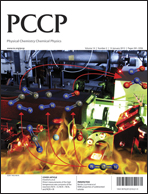The role of conformational changes in the signal enhancement of a selective chemosensor of Pb2+†
Abstract
In this work, the complexes formed by a fluoroionophore with three dications (M2+ = Ca2+, Hg2+ and Pb2+) were studied theoretically, by applying both Density Functional Theory and its Time Dependent version (TDDFT). The experimental information concerning this fluoroionophore–Pb2+ complex indicates a large increment in the absorption and emission signals. From a theoretical point of view, by using the structure with minimum energy of the fluoroionophore free as reference; distortions in the structure are observed when the complexes are formed and consequently important changes in terms of certain properties occur. Although there are increments in signal intensity in the case of the three ions considered here, TDDFT predicts that the Pb2+ complex will manifest the most pronounced response and this conforms to experimental observations. Thus, we can associate the experimentally observed behavior with conformational changes. In order to corroborate this hypothesis we have analyzed the fluoroionophore–M2+ structure complexes, both with ions, without ions and without the


 Please wait while we load your content...
Please wait while we load your content...